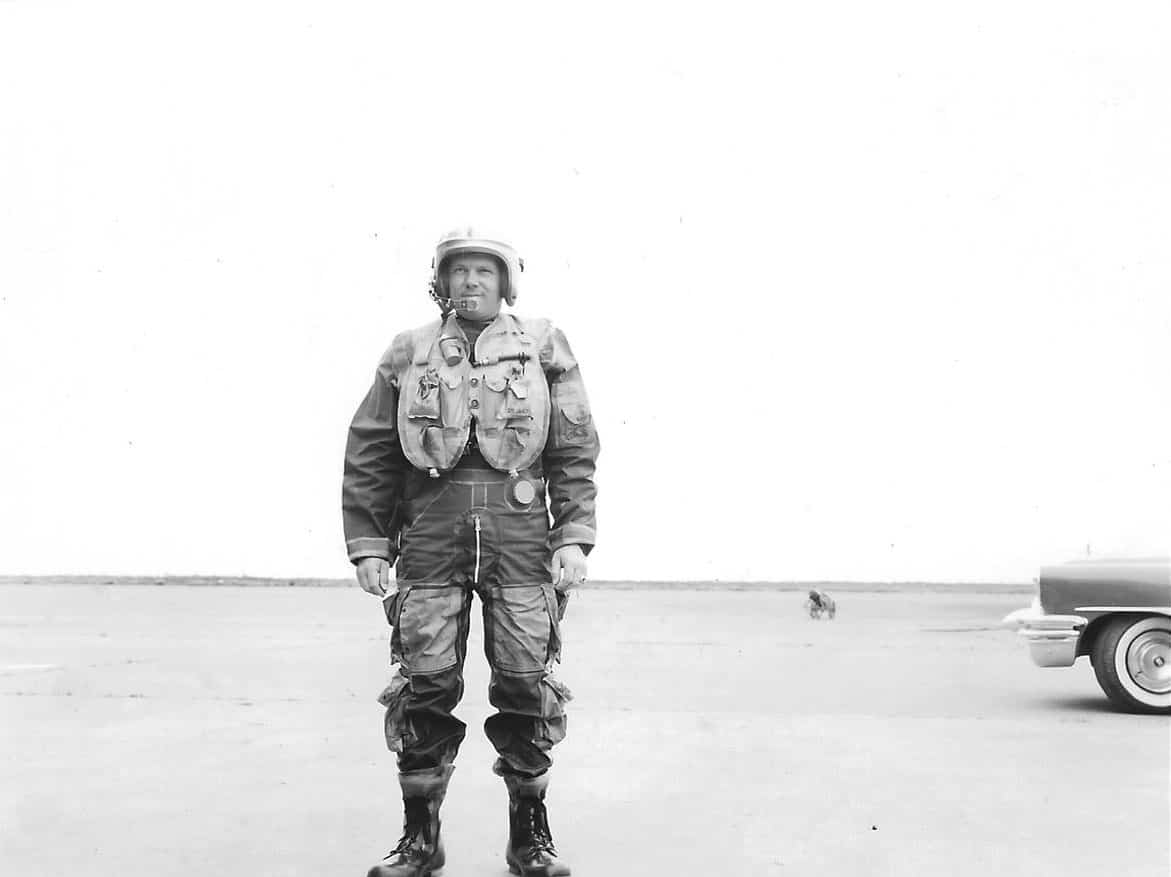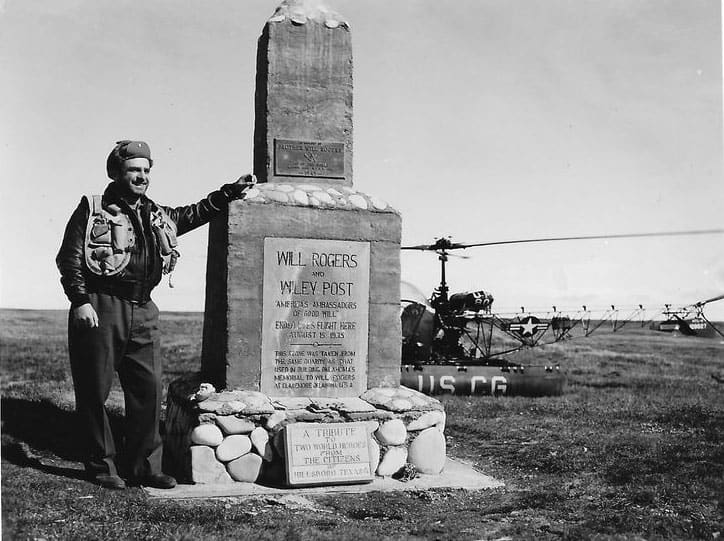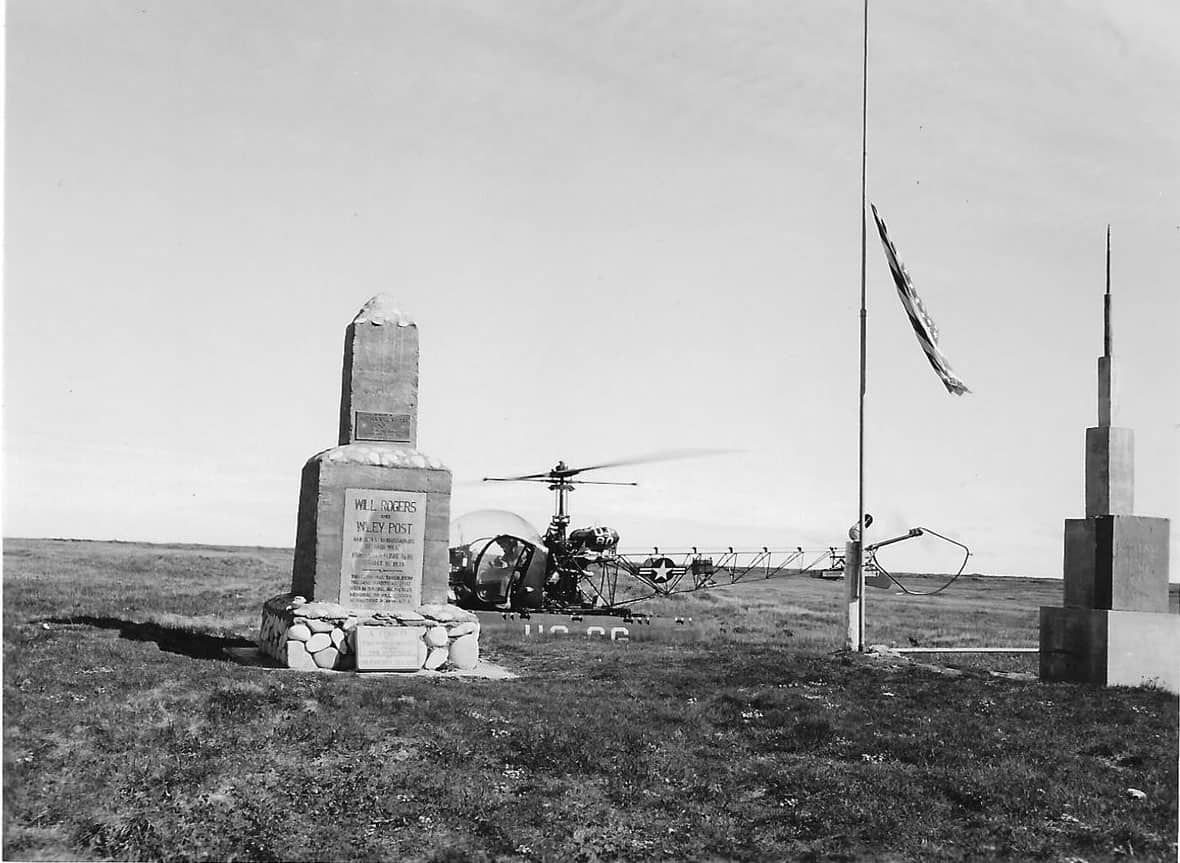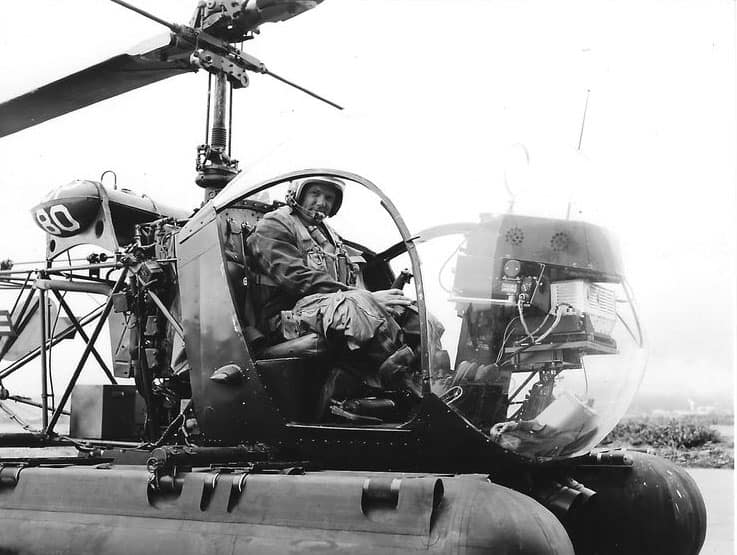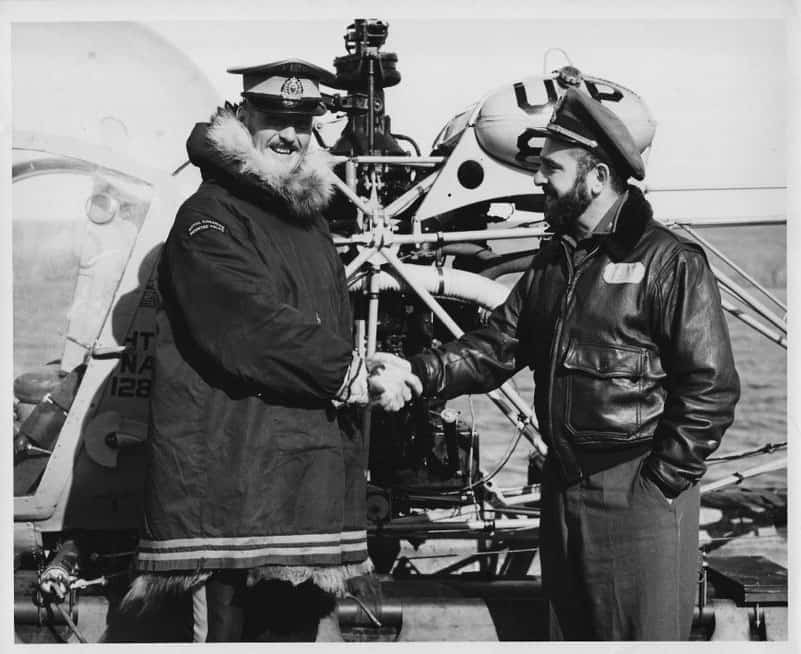by CAPT Jim Durfee

In the early 1950s, the need was determined for a radar network across the top of Alaska and Canada for what was considered at the time a serious potential threat from missiles that might be launched from the Soviet Union into many critical targets in the United States. This was at the time of what was considered “cold war” when relations between the two Nations was anything but friendly and the Soviet Union was known to possess such capability. At the time, there was little in place to provide a realistic defense system in the area. At the same time, the Arctic presented a difficult region in which to develop such a defense in as much as ice conditions during the parts of the year were formidable. In addition, on the maritime route across northern Canada (commonly called the Northwest Pass) had experienced little Marine navigation and the route under consideration had been surveyed on a very limited basis and almost no aids to navigation were in place. The U.S. Navy was tasked with logistics support of what was called the Distant Early Warning (DEW) Line. Due to the strong possibility of ice impeding passage of supply vessels and the requirement for marine survey and placement of aids to navigation, the U.S. Coast Guard, was included in the project under the Navy to provide support in these areas. At the time, the Coast Guard possessed the only true United States icebreaking capability in the marine environment with the Wind-class icebreakers.
Two Coast Guard ships were designated for the project, CGC NORTHWIND and CGC STORIS. It was recognized early that helicopter support would be essential to the project for navigation through heavy ice and transport of officials between vessels in the ice when small boats could not be used. NORTHWIND was superb for the task due to her icebreaking capability and her existing helicopter handling ability. She had considerable ice experience, both in the Arctic and Antarctic. However, STORIS had no helicopter handling ability except for refueling the aircraft in a hover over the aft deck or alongside the ship. STORIS had limited icebreaking capability, but she did have a strong icebreaking bow and considerable experience in the lower Arctic. She was designed as an aids to navigation vessel. An attempt to circumnavigate the North American continent several years earlier by STORIS was unsuccessful due to heavy ice conditions at the time.
It was planned to modify STORIS to permit takeoff and landing of helicopters by constructing a suitable landing platform over the top of the stern deck. Space was made available for maintenance personnel to perform essential maintenance under cover and to store maintenance equipment and spare parts. Fuel storage and handling capability already existed on STORIS. The Navy agreed to supply four Bell HTL helicopters (later H-13), two helicopters for NORTHWIND and two for STORIS. The Navy was then using the HTL on a limited basis and the Coast Guard was flying the HTL aircraft daily in New York harbor on Port Security missions out of Coast Guard Air Station Brooklyn, NY. Pilots and crewmembers for the project were selected from the New York Port Security Detachment. It was anticipated that the assignment would be less than six months since winter ice conditions would prevent supply by ship after that. Crews consisted of two pilots and four enlisted maintenance personnel with a Chief Petty Officer in charge of maintenance. One crew was assigned to NORTHWIND and the other crew to STORIS. Pilots assigned to NORTHWIND were CDR David Gershowitz and LCDR Easter, and pilots assigned to STORIS were CDR Fletcher Brown and LCDR James Durfee. The mission began with the collection of personal clothing and fitting of wetsuits since practically all of the flying would be over icy cold water and solid ice.
The two crews assembled at Air Station Brooklyn and boarded a Coast Guard Douglas R5D Skymaster for the flight to Seattle to meet NORTHWIND and STORIS. The flight was uneventful, and our crew arrived at STORIS at approximately the same time as the two HTL helicopters we would be flying on the mission. It was interesting to watch the two HTL helicopters being stowed on board STORIS for the voyage. STORIS had a large crane over the flight platform that was used to transfer the helicopters to the ship. Both HTLs were equipped with floats, which made placement on the ship more difficult. Once the aircraft were stowed and secured our crew was shown their quarters for the voyage.
The commanding officer of STORIS was CDR Harold L Wood who stated he had little experience with helicopters and would refer to CDR Brown for advice during the voyage.
The next day STORIS departed Seattle and proceeded North via the Inland Passage through Canadian waters. Our first planned stop was Juneau, AK. STORIS had loaded considerable supplies for the trip but the stop in Juneau provided opportunity to load some consumables. Enroute to Juneau the weather was very clear with little wind and there was no opportunity to fly the helicopters before departure. The pilots had not taken off or landed on the small platform that was constructed on STORIS aft deck. CDR Brown was anxious to fly with ideal weather conditions. In addition, the crew of STORIS had never experienced helicopter operations on board and many small details had to be developed and executed for safety and effective handling. The large crane which extended over the aircraft permitted the aircraft to depart the deck only to the side. This did not become a problem for departure and return at any time during the voyage. However, the crane caused a serious problem later in the trip which will be discussed later. After all preparations were made on STORIS to allow the helicopter to depart and return, CDR Brown and I took off and flew near STORIS for about 30 minutes. Takeoff posed no problem and landing back on the ship was accomplished expertly despite the very limited size of the landing area and forward movement of the ship. Both pilots made several landings and takeoffs to familiarize themselves with the procedure. This was executed without difficulty and both pilots felt more confident that STORIS missions could be completed with favorable conditions.
We continued our voyage to Juneau in the beautiful Inland Passage and experienced a spectacular Alaskan sunset. As the sun went down, we reached Juneau the next day and moored at the city dock. STORIS’ crew went about it’s necessary duties and no flying was scheduled. CDR Brown requested of CDR Wood that some flight time be permitted in the area to exercise the aircraft since we would not have much opportunity before reaching ice fields. CDR Wood was not enthusiastic but after pleading agreed. Both pilots boarded one aircraft and flew over the Mendenhall glacier and in the vicinity of the city for an hour. The pilots returned to the ship and secured the aircraft.
We departed Juneau in the morning for a planned stop in Nome, AK to gather mail for ship’s crew and our crew. Enroute the weather deteriorated somewhat with very fresh winds. We continued in the inland passage and entered Wrangel Narrows the next morning. The sky had cleared but the wind was brisk. We were awakened by a grinding sound and sudden stop of the ship, and we learned STORIS had run aground and was working to get free. With ship power and maneuvering the ship was able to come free but it quickly became obvious damage was incurred; a hole was open in the hull. Damage control pumps were able to prevent any serious flooding of the hold. STORIS was unable to continue her voyage until after repairs were made. A survey of ship yards capable of making the necessary repairs revealed that Seattle was the nearest, we would have to return there.
An estimate of the time to complete repairs and return to the mission operating area indicated that STORIS could still be employed on the project as planned. Consequently, STORIS returned to Seattle for repairs. During the repair period we moved the aircraft and personnel to a very hospitable Air Station Port Angeles WA.
When STORIS reached the repair yard all the cargo and food supplies for the voyage had to be removed from the ship hold in which repairs would be made. This was a task calling for all hands to turn to expedite the time spent in the repair yard.
During the period very little flying was done but the maintenance crew under ADC Ed Slanzik checked the aircraft over and painted U.S. COAST GUARD on the side of the rubber floats. We chose big bold letters so there was no doubt as to who was flying them. Later in the mission we had reason to reconsider our decision, more on that later. In the meantime, STORIS had completed repairs and prepared to return to sea.
July 4, 1955, both aircraft were flown from Port Angeles to NAD, Bangor WA to meet the STORIS. We flew aboard STORIS in mid-stream after she departed NAD Bangor and steamed out the channel. Our next stop would be Nome AK, after crossing the Gulf of Alaska. No flying was planned until we arrived at Nome. While in route we assembled an emergency kit which would be carried on aircraft in event of emergency after landing. Enroute, we crossed the Arctic Circle. The kit consisted of sleeping bags, rifle, rations, signal mirror, matches, gloves, socks, and a paulin. The weather had been very fair to this point but after traversing Unimak Pass and entering the Bering Sea it started to deteriorate almost as if it was expected because of our location. Enroute to Nome the Commandant notified STORIS that an inspection of a tail rotor hub was needed. Such an inspection involved disassembling the tail rotor assembly. Reassembly requiring rebalancing of the tail rotor could not be accomplished on STORIS but was planned after arrival at Nome. The tail rotor hub on one HTL had to be replaced, the other HTL proved to be satisfactory.
We reached Nome on July 12, 1955, and anchored. The USS REQUISITE, a U.S. Navy, utility vessel, was anchored nearby. We were traveling in company with REQUISITE for the rest of the voyage. The weather the next day was more like one might expect in Alaska, but several flights were made into Nome in far different conditions than we had experienced today. Ship motion and wind proved to be challenging but were handled safely.
Departure from Nome was at midnight with REQUISITE – however, it was still light due to the long period of daylight with the season. Both ships would rendezvous with NORTHWIND at Point Hope, AK. Enroute, we crossed the Arctic Circle. We rendezvoused with NORTHWIND early on the morning of July 18, and three ships continued in company. The first ice fields were encountered later in the day but were easily navigable except for REQUISITE. She became trapped in ice at one point and was broken out by NORTHWIND. The three ships continued on course for Point Barrow and clear water after leaving the earlier ice field. While in clear water the commanding officer, executive officer, and operations officer of STORIS were flown to NORTHWIND for a conference, before reaching Point Barrow and then return to STORIS. More heavy ice was encountered between Icy Cape and Point Barrow preventing forward progress. A Southwest wind was causing the ice to stay close packed near to shore, a condition that was to be encountered many times during our voyage. REQUISITE had considerable difficulty penetrating the heavy ice. Before reaching Point Barrow, NORTHWIND advised she had broken one blade on the propeller and might have to return to Seattle for repairs. The better part of four days was spent waiting for the ice field to move north so passage to Point Barrow could be made. Ice and weather conditions look favorable to reach Point Barrow on July 23 but an incident occurred that further delayed progress. I was on an ice reconnaissance flight, with LTJG Mortensen, an ice specialist who transferred to STORIS from NORTHWIND. We had spent close to an hour looking carefully for a best route to Point Barrow and were returning to STORIS over the beach line when the helicopter began to lose power. We were flying down wind at an altitude of about 100 feet when the engine stopped. In autorotation, I attempted to turn 180° to land into the wind but we did not have enough time and could only turn 90 and left us facing the edge of the water. Since we had floats on the helicopter, I hoped we could reach water beyond the beach line, but that was not possible. As a result, we hit the beach right at the water line and bounced up and came down upside down. We came to rest in 3 feet of water with both our heads and torsos underwater. Mortensen vacated the helicopter cockpit immediately. As I attempted to leave the helicopter, I tried to release the safety belt but for some reason it would not come free. After several tugs on the belt release handle, it came free, and I was able to leave the helicopter. There was probably only about 15 seconds before release, but it became a very anxious 15 seconds. STORIS was about four or five miles away and did not see our landing on the beach. We signaled to STORIS with smoke and flares to attract their attention. Fortunately, the ice was not heavy between the ship and our location, so a boat was launched to recover us. In addition, NORTHWIND was alerted and launched a helicopter. An attempt by STORIS boat crew to right the helicopter was unsuccessful. So, it was pulled into deeper water, upside down to where STORIS would pick it up by crane and place it on the well deck. This was done to keep the landing pad clear to operate another aircraft. Mortensen and I were transported to STORIS by the NORTHWIND helicopter. There were no personnel injuries, but the temporary loss of a helicopter caused a loss in air coverage of ice routing. The damaged helicopter was removed by the Navy and replaced by another HTL. In the meantime, the second storage helicopter was still out of commission due to the tail rotor problem discussed earlier.
We were 15 miles from Point Barrow, our immediate destination, and considerable ice was between us. It was July 25, and we had not reached Point Barrow. Instead, during the night the ice pack carried north to 18 miles from Point Barrow with 10 miles of heavy ice to transit to open water. With slow progress being made, another casualty occurred aboard STORIS. The crane on STORIS hovers over the flight deck and was being operated, and the operator left; the crane in operation to attend to another matter. When the crane reached the upper limit of travel the cable broke and allowed the crane arm to fall to the flight deck. An 8-foot squared, section of the fight deck was broken and had to be replaced. Fortunately, no one was injured despite five or six persons, working on the flight deck at the time. The broken cable did become wound around a rotor blade on our only capable aircraft of being operated upon completion of the tail rotor problem. NORTHWIND reported they had a spare set of rotor blades to replace our damaged one. Balancing will still be required on the new blades before flying.
A message was received by all ships that STORIS had priority on helicopter support and BURTON ISLAND was responsible for ensuring STORIS had two operational helicopters before leaving the area. Because of tail rotor problems the only operational aircraft were on BURTON ISLAND – those would be transferred to STORIS, along with a main rotor assembly. The group of vessels continued on to rendezvous with BURTON ISLAND a distance of 200 miles. Enroute a moderately heavy ice field was encountered which required BURTON ISLAND to take REQUISITE in tow very close astern with STORIS following in the wake. Relatively open water was reached early the next morning as we neared Barter Island. All ships anchored, awaiting the arrival of a Canadian Air Officer who has considerable area experience, and would accompany BURTON ISLAND as an advisor. We continued the voyage, encountering heavy ice during the night, which resulted in much hull damage to REQUISITE and bending of the propeller shaft, limiting the speed to 12 knots. We passed Herschel Island in the day and began the survey route to which we were assigned sounding, bearings and placing temporary buoys in place.
We reached Cape Bathurst on August 1 and transferred, one damaged helicopter to the BURTON ISLAND. In exchange we received one fully operational HTL4 and finally STORIS had two operational helicopters. It had been quite a few days since we had a flyable aircraft.
BURTON ISLAND left us at Cape Bathurst and STORIS and REQUISITE headed east that night and anchored off Cape Parry earlier the next morning. Mail has been a continual problem, and none was at Cape Parry for STORIS or REQUISITE when we arrived. The mail had been delivered to a post 40 miles behind us, so a Canadian PBY offered to pick it up for us. They returned with 800 pounds of mail for STORIS and REQUISITE. Happy day.
Considering the maintenance problems we had, and many problems the aircraft maintenance crew had adjusting to shipboard operations, we had been fortunate to have an extremely confident and cooperative group of personnel. At the same time STORIS ship’s crew has done everything they could do to assist in flight operations even though STORIS had never operated helicopters before. Several changes made by STORIS to expedite takeoffs and landings Radio antennas were moved to the superstructure deck, the crane was kept in the top position. Most of the time, deck railings were left in a down position, and the fuel hose was rigged to the edge of the deck to augment, the use of safety cans to refuel all the aircraft. Coast Guard Day was recognized on August 4 with holiday routine on STORIS but otherwise operations were normal. After getting underway, both ships steamed toward Cambridge Bay. The water was safe to navigate in this area with no ice. We reached Cambridge Bay the next day and stayed anchored for two days in Cambridge Bay. A Royal Canadian mounted police post was here with two constables serving and about 100 Eskimos live here. Commander Wood went on an ice recon flight aboard a Canadian PBY. While still anchored in Cambridge Bay on 7 August the sky was clear and there was a little wind causing the surface of the water to be like glass and making it very difficult to determine the surface from above it. CDR Brown, and LT Bogucki, were airborne, in one helicopter to perform a variety of missions. One of the missions was to assist STORIS in calibrating their radar by landing on the water a given distance from a critical shoal. The glassiness of the water surface made it almost impossible to estimate the surface of the water accurately. As the helicopter approached the water it made motion sidewards of the helicopter very difficult to recognize. As a result, the landing helicopter had motion to the side which the pilot did not see. When the helicopter hit the surface of the water, it immediately caused the helicopter to rotate to upside down in the water. The two persons inside, evacuated the helicopter and climbed up on the inverted floats on top of the water. The two crewmembers from the crashed helicopter were recovered by STORIS. The helicopter was lifted from the water by crane and placed on STORIS deck.
Following the accident STORIS laid several buoys to aid later ships in navigating the channel area and then proceeded out a channel to rendezvous with REQUISITE. The two ships encountered a moderately heavy ice field as they approached the Nordonshield Islands the following day, and after an aerial scout of the ice, they anchored south of the icefield overnight. REQUISITE had been heavily battered by the ice and her condition was mainly the reason for the caution. The wind was holding the ice well packed, and conditions did not improve sufficiently to continue our planned route. On the third day, the ice on the route proved to be too difficult to penetrate, and a decision was made to backtrack to Jenny Lind Island to review alternatives. As a result, NORTHWIND was called upon to attempt a route that was considered earlier. NORTHWIND found it could transit the ice, but many shoals existed on the route that was hazardous for the cargo ships. Many exploratory attempts were made over a period of three days with helicopter support but none of the routes proved navigable and the ships returned to Jenny Lind Island and anchored. The main group of supply ships consisting of cargo ships and LST’s was getting closer to our position and seemed anxious to press on but ice conditions ahead were still the problem.
STORIS got underway the next morning to find a suitable route for the cargo ships. The weather was clear and beautiful as it can be in Alaska, and we encountered a mirage that is not uncommon in these waters. The mirage forms just above the horizon and the land and water (and ice) are so perfectly reflected in the mirage that it creates the effect of being several hundred feet in the air. The area in which we were moving had not only moderately heavy ice, but consisted of many shoals that were not clearly evident and required considerable caution. Our mission, as well as the time of year demanded progress before it turned colder again, and ice condition became even more formidable. We reached Simpson Strait and during the night were joined by two LST’s and a cargo ship. Another cargo ship had run aground about 20 miles behind our position, and they have been unable to get free. They will probably get assistance from another ship in the convoy. As STORIS conducted a survey of the area, REQUISITE made chart overlays to assist other ships transiting the waters. STORIS was to establish a channel through the area. Another problem was encountered in that the current in Simpson Strait was so strong it pulled the buoys under the water requiring heavier chain to keep them above water.
A significant event was noted on the next day, when the three ships being escorted by STORIS reached Shepherds Bay, the eastern most point of the voyage, all cargo was planned to be placed ashore in three days. REQUISITE had to spend several days in Shepherds Bay making repairs. A salvage tug assisted REQUISITE in the repairs. STORIS meanwhile returned to Queen Maud Gulf to survey an alternate route for later ships. Ice conditions had improved but the area was largely unsurveyed and shoal areas made for difficult navigation. Much of the time was now spent escorting additional cargo ships to the site and in surveying areas not previously covered. STORIS laid many more buoys to mark the route.
August 21 and our mission has been completed but we will likely remain in the area until all cargo ships have discharged their cargoes. STORIS received a message two days later, detaching STORIS, and directing her to proceed, West to Herschel Island to assist NORTHWIND and BURTON ISLAND in taking the cargo ships through the ice fields. Heading West toward Point Barrow was good news and led us to feel we were on our way home. From Herschel Island we took the lead of 13 cargo ships headed for Barter Island. The officials heading the entire operation were apparently concerned about ice conditions at this stage of the season. Normally the waters completely ice free by now but this year they are having considerable trouble getting the ships through. The operation is behind schedule and promises to remain so unless ice conditions improve greatly. Enroute to Barter Island NORTHWIND relieved STORIS of all that they were leading to enable STORIS to return and pick up a group of ships awaiting departure at Herschel Island.
Upon arrival, STORIS anchored, and remained so for two days due to weather conditions and arrival of additional cargo ships from the east. Their current operation consisted of escorting cargo ships from east to west until all cargo ships could proceed unescorted.
It started to snow on the evening of September 1 and continued for the next two days. By the morning of September 3 about 4 inches of snow had accumulated. Although ice conditions in the operating area were not having adverse effect on movement of the cargo ships at this point, it became clear that winter was approaching. Finally, all cargo ships and LST’s had unloaded cargo and were returning to clear waters. Some ice conditions enroute proved difficult but could be usually handled by NORTHWIND and BURTON ISLAND. STORIS was again detached and released to return to their home port independently. We were going home.
Not so fast! Consideration was being given by Commander Wood to proceeding across the top of Canada to the East Coast of the United States. It had been attempted only once by a Coast Guard ship but that was unsuccessful due to ice conditions enroute. So our route home was likely to change but STORIS headed east to enter Icy Strait. Some ice was encountered enroute, but it was not a problem until we entered Icy Strait. As feared, the outlook was not favorable, and after a day at anchor to consider our options, the decision was made to return to Point Barrow. The trip west to Point Barrow was uneventful, and no heavy ice was encountered.
It was decided that STORIS aviation personnel could disembark at Point Barrow and return to New York. So, Air Station Elizabeth City was notified, and a request was made for the R5D transport to proceed to meet us at Point Barrow and transport the group to Air Station Brooklyn, our home. Thus, our role in the DEW LINE operation was completed, and except for some unplanned occurrences, it was successful, and arrival home was welcomed by all. We could all boast that we crossed the Arctic Circle.

